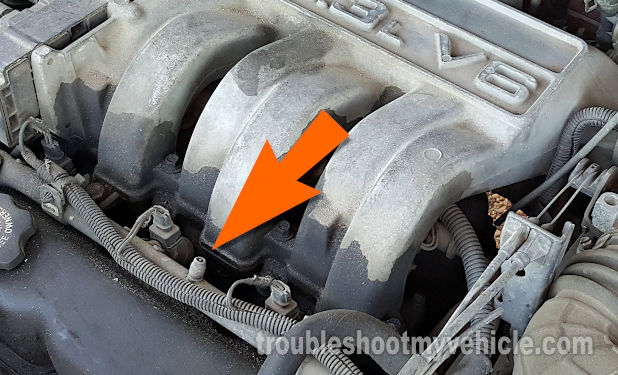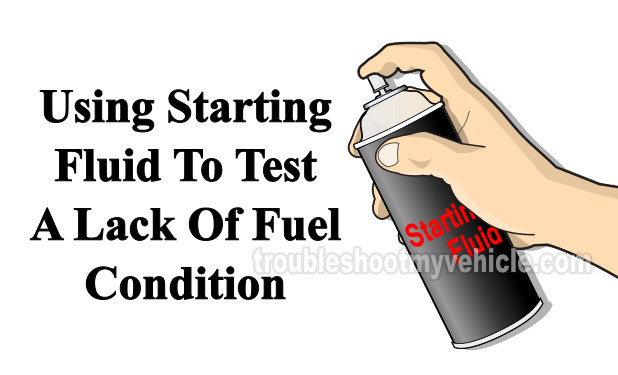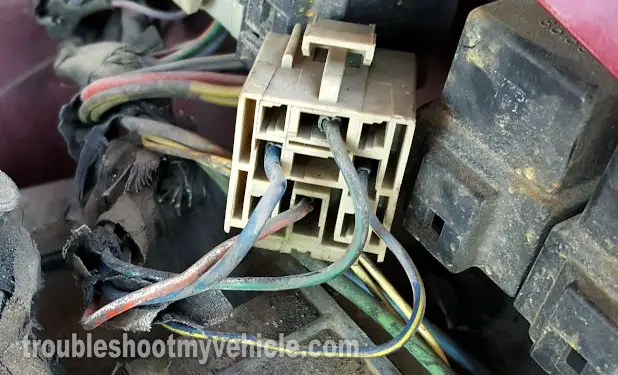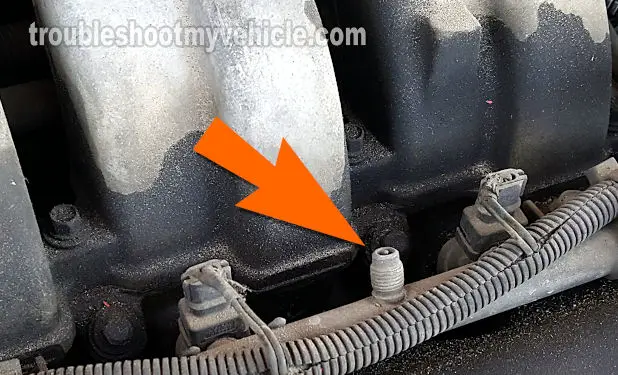
A bad fuel pump will cause your 3.3L V6 Chrysler (Dodge or Plymouth) minivan to not start due to a lack of fuel to the fuel injectors.
A failing fuel pump will cause major engine performance issues, even though the engine starts and runs.
Thankfully, the fuel pump can easily be tested with a fuel pressure test gauge and in this tutorial, I'll explain how to do it.
Contents of this tutorial:
- Symptoms Of A Bad Fuel Pump.
- Where To Buy A Fuel Pressure Test Gauge.
- TEST 1: Checking Fuel Pressure With A Fuel Pressure Gauge.
- TEST 2: Using Starting Fluid To Confirm Lack Of Fuel.
- Making Sure The Fuel Pump Is Getting 12 Volts.
- Identifying The Fuel Pump Relay.
- More 3.3L V6 Chrysler, Dodge, And Plymouth Minivan Tutorials.
ES ![]() You can find this tutorial in Spanish here: Cómo Probar La Bomba De Combustible (1992-1993 3.3L V6 Chrysler, Dodge, Plymouth Mini-Van) (at: autotecnico-online.com).
You can find this tutorial in Spanish here: Cómo Probar La Bomba De Combustible (1992-1993 3.3L V6 Chrysler, Dodge, Plymouth Mini-Van) (at: autotecnico-online.com).
APPLIES TO: This tutorial applies to the following 3.3L V6 equipped Chrysler, Dodge, and Plymouth minivans:
- 3.3L V6 Chrysler Town & Country: 1992, 1993.
- 3.3L V6 Dodge Caravan: 1992, 1993, 1994, 1995.
- 3.3L V6 Dodge Grand Caravan: 1992, 1993.
- 3.3L V6 Plymouth Voyager: 1992, 1993.
- 3.3L V6 Plymouth Grand Voyager: 1992, 1993.
FUEL PUMP TEST TUTORIALS:
- How To Test The Fuel Pump (1994-1995 3.3L V6 Chrysler, Dodge, And Plymouth Minivan).
- How To Test The Fuel Pump (1996-1999 3.3L V6 Chrysler, Dodge, And Plymouth Minivan).
- How To Test The Fuel Pump (2000 3.3L V6 Chrysler, Dodge, And Plymouth Minivan).
- How To Test The Fuel Pump (2001-2007 3.3L V6 Chrysler And Dodge Minivan).
Symptoms Of A Bad Fuel Pump
A fuel pump generally fails in one of two ways:
- The fuel pump suffers a complete failure.
- The fuel pump starts to fail but doesn't fail completely.
Here are some specific symptoms of when a fuel pump completely fails.
- The engine turns over but will not start.
- All 6 spark plug wires are sparking (confirming it's not an ignition system problem).
- The PCM will still pulse (activate) all 6 fuel injectors (as confirmed by a Noid light test).
But when the fuel pump is failing (but hasn't failed completely), your 3.3L V6 Chrysler (Dodge or Plymouth) minivan will start and run but with engine performance problems. You'll probably see one or more of the following symptoms:
- Rough idle.
- Engine starts after extended cranking.
- Lack of power when accelerating the vehicle down the road.
- Back-fires thru' the intake manifold when accelerating your vehicle down the road.
- Lean air/fuel mixture trouble codes: P0171 or P0174 or both.
Whether the fuel pump is the cause behind your 3.3L V6 Chrysler (Dodge or Plymouth) minivan's no-start problem or engine performance problem, you can find out with a simple fuel pump pressure test. Alright, with this info under our belts, let's get testing.
Where To Buy A Fuel Pressure Test Gauge
You can buy a fuel pressure test gauge just about anywhere and is one of the most important tools any serious DIY'er should have in his/her tool box.
The following fuel pressure test gauge kits are pretty good deals and will work with your 3.3L V6 Chrysler (Dodge or Plymouth) minivan:
Disclosure: As an Amazon Associate, I earn from qualifying purchases. If my tutorials help you, using these links is an easy way to support the site at no extra cost to you. Thank you!
TEST 1: Checking Fuel Pressure With A Fuel Pressure Gauge
In the photo above is pictured the Schrader valve and this valve is what makes testing the fuel pump a piece of cake.
It's to this valve, which is located on the fuel injector rail facing the radiator, that we're going to connect the fuel pressure test gauge to.
If the fuel pump is functioning correctly, you should see a fuel pressure specification of: 48 PSI with the key on and engine off and the fuel pump activated.
NOTE: If you don't have a fuel pressure gauge, take a look at the section: Where To Buy A Fuel Pressure Test Gauge.
CAUTION: The test instructions below will ask you to jumper together two female terminals of the fuel pump relay socket. Be careful and do not insert anything into the female terminals that is wider than the male terminals that connect to them, or you run the risk of damaging them.
OK, let's get started with this test:
- 1
Place a shop towel around the Schrader valve. The shop towel's job is to absorb any fuel that may leak when doing step 2.
- 2
Connect the fuel pressure gauge to the Schrader valve on your 3.3L V6 Chrysler (Dodge or Plymouth) minivan's fuel injector rail.
- 3
Locate the fuel pump relay and disconnect it from its electrical connector.
You can identify the fuel pump relay by the colors of the wires that connect to it. For more info see this section: Identifying The Fuel Pump Relay. - 4
Jumper together fuel pump relay socket female terminals 1 and 2 with a jumper wire (see photo 2 of 2 above).
The green with orange stripe wire (GRN/ORG) wire connects to female terminal labeled with the number 1.
The red with white stripe (RED/WHT) wire connects to female terminal labeled with the number 2. - 5
The fuel pump will activate.
At this point check the connection at the Schrader valve for fuel leaks and if any tighten the fuel pressure tester a bit more (by hand only) to eliminate them. - 6
Your fuel pressure gauge should register: 48 PSI.
Let's take a look at what your results mean:
CASE 1: The fuel pressure gauge registered 0 PSI. This test result lets you know that the no-start problem is caused by a lack of fuel from the fuel pump.
Take a look at the suggestion found here: Making Sure The Fuel Pump Is Getting 12 Volts.
CASE 2: The fuel pressure gauge registered a pressure below the indicated PSI. This test result lets you know that the fuel pump is failing.
CASE 3: The fuel pressure gauge registered the indicated PSI. This is the correct test result.
With this test result you can conclude that the fuel pump is working and delivering enough fuel to the fuel injectors. You can also conclude that your 3.3L V6 Chrysler (Dodge or Plymouth) minivan is not starting due to another reason. The fuel pump is OK.
TEST 2: Using Starting Fluid To Confirm Lack Of Fuel

A very common test, to see if the engine is not starting due to a lack of fuel, is the starting fluid test.
I've used this test many times and I can tell you that it's effective (although not the most accurate way to test the fuel pump).
NOTE: To get an accurate test result from the starting fluid test, it's important that you make sure that all six spark plug wires are sparking.
IMPORTANT: This is a very fast and easy test but you do have to take one very important safety precaution and this is to reconnect the air intake duct back to the throttle body after spraying starting fluid down the throttle bore (although you don't have to fasten it). This will prevent any backfire, that might occur, from scaring the heck out of you when cranking the engine.
These are the test steps:
- 1
Remove the intake air duct from the throttle body. You don't have to completely remove it, since you'll have to reconnect it in one of the next steps.
- 2
Open the throttle plate and spray starting fluid down the bore.
As a safety precaution reconnect the air duct after you have sprayed a good squirt of starting fluid (but you don't have to tighten the air duct). - 3
Crank the engine once the air duct is back on and you're clear of the engine compartment.
- 4
You'll get one of two results with this test:
1.) The engine will start momentarily and after a few seconds will die or.
2.) The engine will only crank but not start at all.
OK, let's analyze your test result:
CASE 1: The engine started and ran for a few seconds. This test result confirms that a lack of fuel is keeping your min-van's 3.3L V6 engine from starting.
Your next step is to check to see what the fuel pressure is with a fuel pressure test gauge. Go to: TEST 1: Checking Fuel Pressure With A Fuel Pressure Gauge.
CASE 2: The engine did not start, not even momentarily. This usually means that a lack of fuel IS NOT the reason your car is not starting.
Now, remember what I said about this test not being very accurate? Well, I suggest you do one more test and this is to check the fuel pressure with a fuel pressure test gauge. Go to: TEST 1: Checking Fuel Pressure With A Fuel Pressure Gauge.
Making Sure The Fuel Pump Is Getting 12 Volts
If you found that the fuel pump is not producing any pressure, then it's important that you make sure that it's getting power.
Specifically, you should:
- Make sure the fuel pump fuse is not blown.
- Make sure that the fuel pump relay is functioning correctly.
- Make sure that 12 Volts are reaching the fuel pump connector.
Why check all of these things? Because in some cases the fuel pump does not function because it's not receiving 12 Volts.
You can check the fuel pump fuse just by removing it and making sure that it's not blown.
The fuel pump relay can be bench-tested or you can swap it out with a similar one.
To check that 12 Volts are present at the fuel pump connector is a bit more complicated. Personally, I've done this as I'm removing the gas tank and the connector is accessible.
Once I've unplugged the fuel pump connector, I then connect my multimeter (set to Volts DC) and probe the terminal that delivers 12 Volts to the fuel pump as a helper cranks the engine.
If 12 Volts are present, then I know that replacing the fuel pump will solve the no-start due to a lack of fuel problem.
If 12 Volts are not present, then I know that replacing the fuel pump won't do any good since without power, the new one won't work either.
Identifying The Fuel Pump Relay

The fuel pump relay is located on the left-side inner fender (in the engine compartment). To be more specific, it's located above the fuel injection computer and next to the battery.
You can identify the fuel pump relay by the colors of the wires coming out of its socket. To do this, disconnect the fuel pump relay from its electrical socket. Turn the socket over and check the color of the wires.
The color of the wires of the fuel pump relay socket are:
| Pin | Wire Color | Description |
|---|---|---|
| 1 | DK GRN/BLK (dark green with black stripe) | 12 Volts output (to fuel pump) |
| 2 | RED/WHT (red with white stripe) | 12 Volts input (from fusible link) |
| 3 | DK BLU (dark blue) | 12 Volts input (from ignition switch) |
| 4 | DK BLU/YEL (dark blue with yellow stripe) | Relay control |
More 3.3L V6 Chrysler, Dodge, And Plymouth Minivan Tutorials
You can find a complete list of tutorials in this index:
Here's a sample of the tutorials you'll find in the index:
- How To Test The MAP Sensor (2001-2004 3.3L V6 Chrysler And Dodge Minivan).
- How To Test The Alternator (2001-2007 3.3L Chrysler).
- How To Test Engine Compression (1991-2007 3.3L V6 Chrysler, Dodge, And Plymouth Minivan).
- How To Test The Coil Pack 3.3L, 3.8L Chrysler, Dodge, Plymouth (at: easyautodiagnostics.com).

If this info saved the day, buy me a beer!






